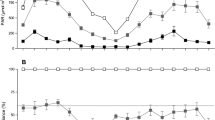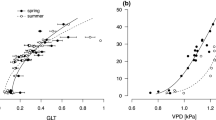Summary
Leaf characteristics and carbon isotope ratios (δ13C) of Adenocaulon bicolor were examined in the understory of a redwood forest along a gradient of microsites that differed in the amount of direct (sunfleck) photon flux density. Comparisons were made between plants that had been shaded from sunflecks with shadow bands but still received diffuse light, and adjacent plants that received both sunflecks and diffuse light. The δ13C of the shaded plants were 1.2‰ lower than predicted from the intercellular CO2 pressure (pi), probably because of recycling of respired CO2 in the understory. Plants receiving sunflecks had higher δ13C values because assimilation during sunflecks occurred at a lower pi than assimilation in diffuse light. The amount that their δ13C was higher was positively correlated with predicted direct photon flux density received by a plant. Leaf weight per unit area increased with increasing PFD. Although plants receiving sunflecks had greater leaf weights per unit area and photosynthetic capacities than those under shadow bands, there was no apparent acclimation of photosynthetic capacity to the differences in PFD among the microsites.
Similar content being viewed by others
References
Baldocchi DD, Matt DR, Hutchison BA, McMillen RT (1984) Solar radiation within an oak-hickory forest: an evaluation of the extinction coefficients for several radiation components for fully-leafed and leafless periods. Agric For Meteorol 32:307–322
Björkman O (1981) Responses to different quantum flux densities. In: “Encyclopedia of Plant Physiology”, New Series, vol. 12A, O.L. Lange, P.S. Nobel, C.B. Osmond, and H. Ziegler, (eds), Springer Heidelberg New York Berlin pp 57–107
Chazdon RL, Fetcher N (1984) Photosynthetic light environments in a lowland tropical forest in Costa Rica. J Ecol 72:553–564
Chazdon RL, Field CB (1987) Photographic estimation of photosynthetically active radiation: evaluation of a computerized technique. Oecologia 73:525–532
Chazdon RL, Field CB (1987) Determinants of photosynthetic capacity in six rainforest Piper species. Oecologia 73:222–230
Chazdon RL, Williams K, Field CB (1988) Interactions between crown structure and light environment in five rainforest Piper species. Am J Bot 75:1459–1471
Farquhar GD, Ehleringer JR, Hubick KT (1989) Carbon isotope discrimination and photosynthesis. Ann Rev Plant Physiol Plant Mol Biol 40:503–537
Farquhar GD, O'Leary MH, Berry JA (1982) On the relationship between carbon isotope discrimination and intercellular carbon dioxide concentration in leaves. Aust J Plant Physiol 9:121–137
Finnigan JJ (1985) Turbulent transport in flexible plant canopies. In: Hutchinson BA, Hicks BB, (eds), Reidel, Dordrecht The Forest-Atmosphere Interaction pp 443–480
Horowitz JL (1969) An easily constructed shadow-band for separating direct and diffuse solar radiation. Solar Energy 12:543–545
Medina E, Montes G, Cuevas E, Rokczandic Z (1986) Profiles of CO2 concentration and δ13C values in tropical rain forests of the upper Rio Negro Basin, Venezuela. J Trop Ecol 2:207–217
Pearcy RW (1983) The light environment and growth of C3 and C4 tree species in the understory of a Hawaiian forest. Oecologia 58:19–25
Pearcy RW (1987) Photosynthetic gas exchange responses of Australian tropical forest trees in canopy, gap and understory micro-environments. Funct Ecol 1:169–178
Pearcy RW (1988) Photosynthetic utilisation of lightflecks by understorey plants. Aust J Plant Physiol 15:223–238
Pearcy RW (1989) Radiation and light measurements. In: Pearcy RW, Ehleringer JR, Mooney HA, Rundel PW, (eds), Chapman and Hall, New York Plant Physiological Ecology: Field Methods and Instrumentation pp 97–116
Pearcy RW, Calkin H (1983) Carbon dioxide exchange of C3 and C4 tree species in the understory of a Hawaiian forest. Oecologia 58:26–32
Pfitsch WA, Pearcy BW (1989a) Daily carbon gain by Adenocaulon bicolor, a redwood forest understory herb, in relation to its light environment. Oecologia 80:465–470
Pfitsch WA, Pearcy RW (1989b) Steady-state and dynamic photosynthetic responses of Adenocaulon bicolor (Asteraceae) in its redwood forest habitat. Oecologia 80:471–476
Schleser GH, Jayasekera R (1985) 462-2 variation of leaves in forest as an indicator of reassimilated CO2 from soil. Oecologia 65:536–542
Sims DJ, Pearcy RW (1989) Photosynthetic characteristics of a tropical forest understory herb, Alocasia macrorrhiza, and a related crop species, Colocasia esculenta, grown in contrasting light environments. Oecologia 79:53–59
Sternberg LSL, Mulkey SS, Wright SJ (1989) Ecological interpretation of leaf carbon isotope ratios: influence of respired carbon dioxide. Ecology 70:1317–1324
Vitousek PM, Field CB, Matson PA (1990) variation in foliar δ13C in Hawaiian Meterosideros polymorpha: a case of internal resistance? Oecologia 84:362–370
Author information
Authors and Affiliations
Rights and permissions
About this article
Cite this article
Pearcy, R.W., Pfitsch, W.A. Influence of sunflecks on the δ 13 C of Adenocaulon bicolor plants occurring in contrasting forest understory microsites. Oecologia 86, 457–462 (1991). https://doi.org/10.1007/BF00318310
Received:
Accepted:
Issue Date:
DOI: https://doi.org/10.1007/BF00318310




